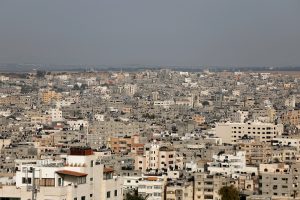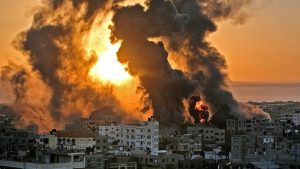In the volatile region of the Gaza Strip, the Palestinian struggle against the Israeli occupation has often been marred by accusations against Palestinian resistance groups like Hamas, suggesting they employ civilians as human shields in their struggle against the Israeli occupation. While this accusation has been extensively propagated, it is essential to examine the geographical and urban realities of Gaza to understand the reasons behind the combat tactics used by these groups, and to challenge the claim that they deliberately place civilians in harm’s way.
The Urban Jungle of Gaza
The Gaza Strip, a tiny enclave measuring just 365 square kilometers, is one of the most densely populated areas on the planet. With approximately two million inhabitants, the urban sprawl leaves little room for maneuvering in a region that is roughly half the size of New York City. This geographic constraint necessitates a closer examination of the tactics employed by Palestinian resistance groups.

Imagine a crowded theater during an emergency evacuation. People are crammed into tight spaces, making it difficult to move swiftly and efficiently. In such situations, civilians inadvertently become obstacles, not human shields. Similarly, the Gaza Strip’s urban structure and population density force resistance groups to operate within close proximity to civilians, not as a deliberate strategy, but as a consequence of their surroundings.
Consider the analogy of a chessboard. In traditional chess, each piece has its designated moves and areas of control. In Gaza, however, it’s as if all the pieces are confined to a few squares, making it impossible to avoid proximity to civilians.
Furthermore, Palestinian resistance groups are deeply embedded within the civilian population due to the lack of military bases or vast open spaces in Gaza. Unlike traditional armies, they lack the luxury of remote training grounds or barracks. This is not a tactic of using human shields but a harsh reality born from the spatial limitations imposed on them.
To better understand the predicament faced by Palestinian resistance groups, let’s draw a real-life parallel with the ongoing conflict in Ukraine. The Ukrainian army, in its fight against Russian occupation forces, has also been compelled to operate from densely populated areas. Ukrainian cities like Donetsk and Luhansk have become battlegrounds, not because the Ukrainian military wishes to use civilians as human shields, but because of the strategic and logistical constraints imposed by the geography and urban structure of the region.
Read more: The Gaza Narrative: Beyond Militias and Myths
The Smokescreen of Allegations
It is essential to question the motives behind the persistent accusations of Palestinian resistance groups using human shields. The allegations often serve as a smokescreen, deflecting attention from the broader issue of Israeli military offensives in Gaza. Numerous reports by respected human rights organizations have documented instances of Israeli occupation forces targeting civilians and civilian infrastructure in their military operations, raising serious concerns about the disregard for civilian lives.
Israel’s Deliberate Targeting of Civilians
One only needs to look at the devastation inflicted on Gaza during recent Israeli aggressions to understand the gravity of the situation. Bombings of residential neighborhoods, schools, hospitals, and even media buildings have raised questions about the proportionality and legality of Israeli occupation actions. The intentional destruction of civilian infrastructure casts doubt on the claim that the Israeli occupation is primarily concerned with the presence of Palestinian fighters in populated areas.

Moreover, it is crucial to remember that Gazans are not mere pawns in this situation. They are individuals with families, homes, and communities who have lived under occupation for decades. It is not uncommon for them to support and shelter resistance fighters out of a shared sense of desperation and defiance.
Critics argue that by firing rockets from densely populated areas, resistance groups knowingly put civilians in harm’s way. However, it’s essential to consider the broader context. Gaza is under a blockade that severely limits the importation of weapons and materials, which pushes these groups to use whatever means are available to them, often homemade rockets. This doesn’t imply a strategy of endangering civilians but rather one of making do with limited resources.
In conclusion, the claim that Palestinian resistance groups intentionally use civilians as human shields must be reconsidered within the unique geographical constraints and urban structure of the Gaza Strip. The reality is far more complex than the accusations suggest. While civilian casualties are undoubtedly tragic and should be condemned, it is crucial to differentiate between intentional strategies used by the Israeli occupation and the unavoidable consequences that Palestinian fighters face.
Shortlink for this post: https://daysofpalestine.ps/?p=50061









